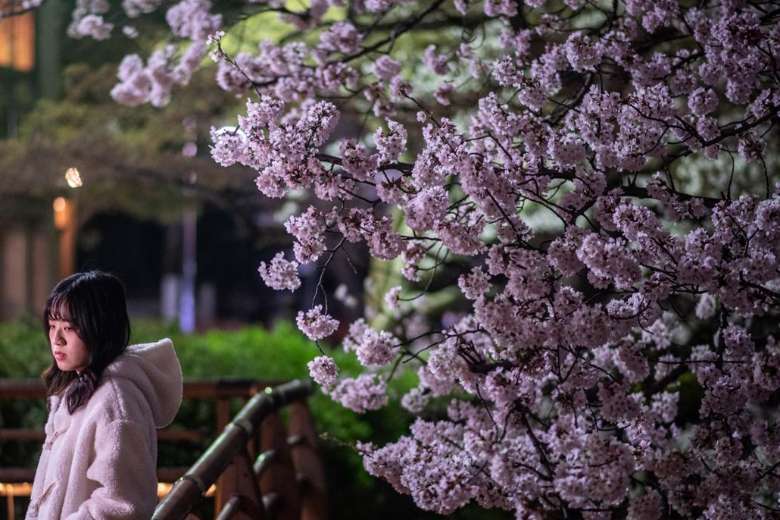

A woman walks past blooming cherry blossoms at Inokashira Park in Tokyo on March 29. (Photo: AFP)
Each spring for about a week Tokyo may be the prettiest and arguably the most convivial metropolis on the planet.
People gather in parks and along riverbanks in the evening to eat, drink, sing and dance under the cherry trees. Even passing strangers are invited to join the fun. One folk song especially popular at this time, Sakura, Sakura (cherry blossoms, cherry blossoms), is probably the world’s most recognizable Japanese tune.
At least such picnics were what people did pre-Covid; hanami (flower viewing) parties are no longer allowed until pandemic precautions are history.
The hanami period in Tokyo begins with an official announcement that an ancient cherry tree at a major Shinto shrine has begun to blossom and reaches its high point several days later with the local government’s announcement of mankai, full bloom throughout the city.
Those announcements are preceded by a few weeks when part of the daily weather forecast includes maps showing the sakura zensen, the cherry front, with predicted blossoming dates for the whole length of Japan.
But the flowers soon fall; mankai only lasts a few days, and even then only if there is little wind. The petite blossoms must be dealt with gently.
Of course, we do not need the government to tell us the cherry trees are blossoming. It is hard, if not impossible, to go more than a block from home in Tokyo without encountering at least one cherry tree
I wonder if there is any other place in the world where a government makes such announcements or where meteorological agencies publish maps predicting blooming flowers.
After more than two years of recurring government announcements of pandemic states of emergency, it's comforting to once again get the annual announcement of full bloom even if we cannot party under the trees.
Of course, we do not need the government to tell us the cherry trees are blossoming. It is hard, if not impossible, to go more than a block from home in Tokyo without encountering at least one cherry tree.
And the trees are indeed beautiful. Pale pink blossoms decorate them until after only a few days the petals begin to fall like snow. In places with many trees, the piles of petals on the street or path can even be as deep as snowfall.
The cherry is not the only beloved flowering tree in Japan. Earlier in the year, while winter cold still stings and prevents picnics, the plum trees bloom. Unlike the cherries, plum blossoms do not fall right away; they hang on through wind and even snow.
Traditionally, the plum is the symbol of the farmers, the people who work in all sorts of adversity, who carry on, who endure.
In some ways plum blossoms may be a more apt symbol of the Japanese people than the transient cherry. Anyone who recalls the resilience of the Japanese after the Great East Japan Earthquake in 2011 or the rebuilding of the nation following defeat in World War II can easily think of Japan as “plummy.”
Yet the cherry is considered both at home and abroad as the symbolic flower of Japan.
The cherry is the flower of the samurai, warriors whose lives are supposed to be beautiful but doomed to be short. During the Pacific War, one type of aircraft used by kamikaze suicide pilots, basically a bomb with a cockpit built into it, was called Ohka (cherry blossom).
The deeper message and meaning of the cherry, however, is not militarism or violence. It is transience, especially the passing nature of beauty, of all that moves us, and ultimately of ourselves.
For those who see with the eyes of the heart, each gift is an infinitely beautiful grace from the One for whom even our short lives are beautiful beyond measure
More than the flower of the samurai, the cherry blossom is the flower of the artist, the philosopher, even the theologian. It is the flower of all of us.
Cherry blossoms remind us to appreciate life, beauty and the other moments and things we encounter while we have them, either in spite of or because of the fact that they will end. And as the falling petals teach, even the end can be beautiful.
The Japanese phrase for this is mono no aware (the “alas” of things), a quiet sadness at the passing nature of all things. It is a bittersweet consciousness that nothing we love lasts, but that does not render the love worthless.
The attitude may be hinted at in English by Shakespeare in his Sonnet 73, “That time of year thou mayst in me behold”:
This thou perceiv'st, which makes thy love more strong,
To love that well which thou must leave ere long.
It is Lent, a time to reflect on our lives and the other gifts we have been given by God but have failed to really receive.
Perhaps we have failed to notice them. Perhaps we reject or ignore them because they are not what we expected or wanted. They may seem small, like the cherry blossom. They may seem too limited, like the mankai period. The cherry trees call us to look, to pay attention, to see.
For those who see with the eyes of the heart, each gift is an infinitely beautiful grace from the One for whom even our short lives are beautiful beyond measure.
We are God’s sakura.
* The views expressed in this article are those of the author and do not necessarily reflect the official editorial position of UCA News.
Help keep UCA News independent
The Church in Asia needs objective and independent journalism to speak the truth about the Church and the state. With a network of professionally qualified journalists and editors across Asia, UCA News is just about meeting that need. But professionalism does not come cheap. We depend on you, our readers, to help maintain our independence and seek that truth. A small donation of US$2 a month would make a big difference in our quest to achieve our goal.